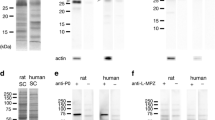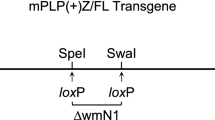Abstract.
The proteolipid protein (PLP) gene codes for the most abundant protein in the central nervous system (CNS) myelin of higher vertebrates. Its function in the myelin sheath is not clear however, a series of point mutations have been shown to have devastating effects on the myelin. The structure of the PLP genes is highly conserved, comprising seven exons that code for an open reading frame of 277 amino acids. We determined a total of 20,957 bp of the porcine PLP gene and compared this sequence with the human PLP sequence. A very high similarity was detected between the non-coding regions of the PLP genes of human and pig, interrupted primarily by several transposable elements. The porcine PLP gene was assigned to the long arm of Chromosome (Chr) X (SSXq2.2-2.4). The analysis of the PLP transcripts revealed three transcription start sites within 160 bp upstream of the translation start codon. Functional studies of the 3′ region showed the use of several polyadenylation signals. Three main transcripts were detected in adult pigs in the range of 3200, 2400, and 1600 nucleotides with Northern blot analysis. The usage of an alternative splice site within exon 3 was shown.
Similar content being viewed by others
Author information
Authors and Affiliations
Additional information
Received: 15 March 1999 / Accepted 5 May 1999
Rights and permissions
About this article
Cite this article
Baumgartner, B., Deppe, A., Rettenberger, G. et al. Molecular analysis of the porcine proteolipid protein (PLP) gene. 10, 895–899 (1999). https://doi.org/10.1007/s003359901110
Issue Date:
DOI: https://doi.org/10.1007/s003359901110




